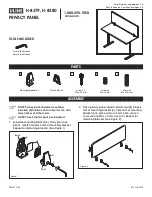
55
Troubleshooting
Troubleshooting Problems, Possible Causes, and Solutions
Troubleshooting
14
This section contains information on troubleshooting and CE Comments.
Troubleshooting Problems, Possible Causes, and Solutions
14.1
In the event that the instrument appears to function abnormally, this section may help
to find and solve the problem. Several possible problem conditions are described along
with likely causes and solutions. If a problem arises, please read this section carefully
and attempt to understand and solve the problem. If the problem cannot otherwise be
solved, contact an Authorized Service Center (see Section 1.3). Be sure to have the
model number and serial number of your instrument available.
Problem
Possible Causes and Solutions
Incorrect tempera ture
reading
Incorrect R0, ALPHA, and DELTA parameters.
Find the value for R0, ALPHA, and
DELTA on the Report of Calibration that was shipped with the instrument. Reprogram
the parameters into the instrument (see Section 9.8.3, Calibration Parameters). Allow the
instrument to stabilize and verify the accuracy of the temperature reading.
Controller locked up.
The controller may have locked up due to a power surge or other
aberration. Initialize the system by performing the Factory Reset Sequence.
Factory Reset Sequence.
Hold the SET and EXIT buttons down at the same time while
powering up the instrument. The instrument displays shows ‘ -
init
-’, the model number,
and the firmware version. Each of the controller parameters and cali bration constants
must be reprogrammed. The values can be found on the Report of Calibration that was
shipped with the instrument.
The instrument heats
or cools too quickly or
too slowly
Incorrect scan and scan rate settings.
The scan and scan rate settings may be set to
unwanted values. Check the Scan and Scan Rate settings. The scan may be off (if the
unit seems to be responding too quickly). The scan may be on with the Scan Rate set low
(if unit seems to be responding too slowly).
An “o” is displayed at
the left of the display
External switch is open.
The external switch is open causing the displayed temperature
to be frozen and keeping the set-point from scanning. Turn the switch test off by pressing
the “DOWN” button on the front panel.
The display shows
any error
Controller problem.
The error messages signify the following problems with the
controller.
Err 1
– a RAM error
Err 2
– a NVRAM error
Err 3
– a Structure error
Err 4
– an ADC setup error
Err 5
– an ADC ready error
Err 6
– Defective control sensor. The control sensor may be shorted, open or otherwise
damaged.
Initialize the system by performing the Factory Reset Sequence described above.
Err 7
– Heater control error. Initialize the system by performing the Factory Reset
Sequence described above.
The stirrer is not
stirring
Stirrer speed needs adjusting.
In the Operating Parameters menu, adjust the stirrer
speed (“
Str Sp
”) to 0. Wait for the motor to stop. Adjust the stirrer speed to a setting
greater than 8 but less than or equal to 25.
Temperature readout
is not the actual
temperature of the
well
Possible RF energy emission.
With the unit stable, slowly rotate the unit. If no change
occurs, the unit may need to be calibrated. If the display changes more than twice the
normal display deviation, another unit in the area could be emitting RF en ergy. Move the
unit to a different location and rotate the unit again. If the temperature is correct in this
new area or deviates differently than the first are, RF energy is pres ent in the room. If you
have to perform the test in the effected area, use the compari son test to eliminate any
possible errors.
Instrument is unstable
Varying line voltage or fluid is not stirring.
Place the unit on a clean power line. If the
fluid is not stirring, turn the instrument off for one minute.


































